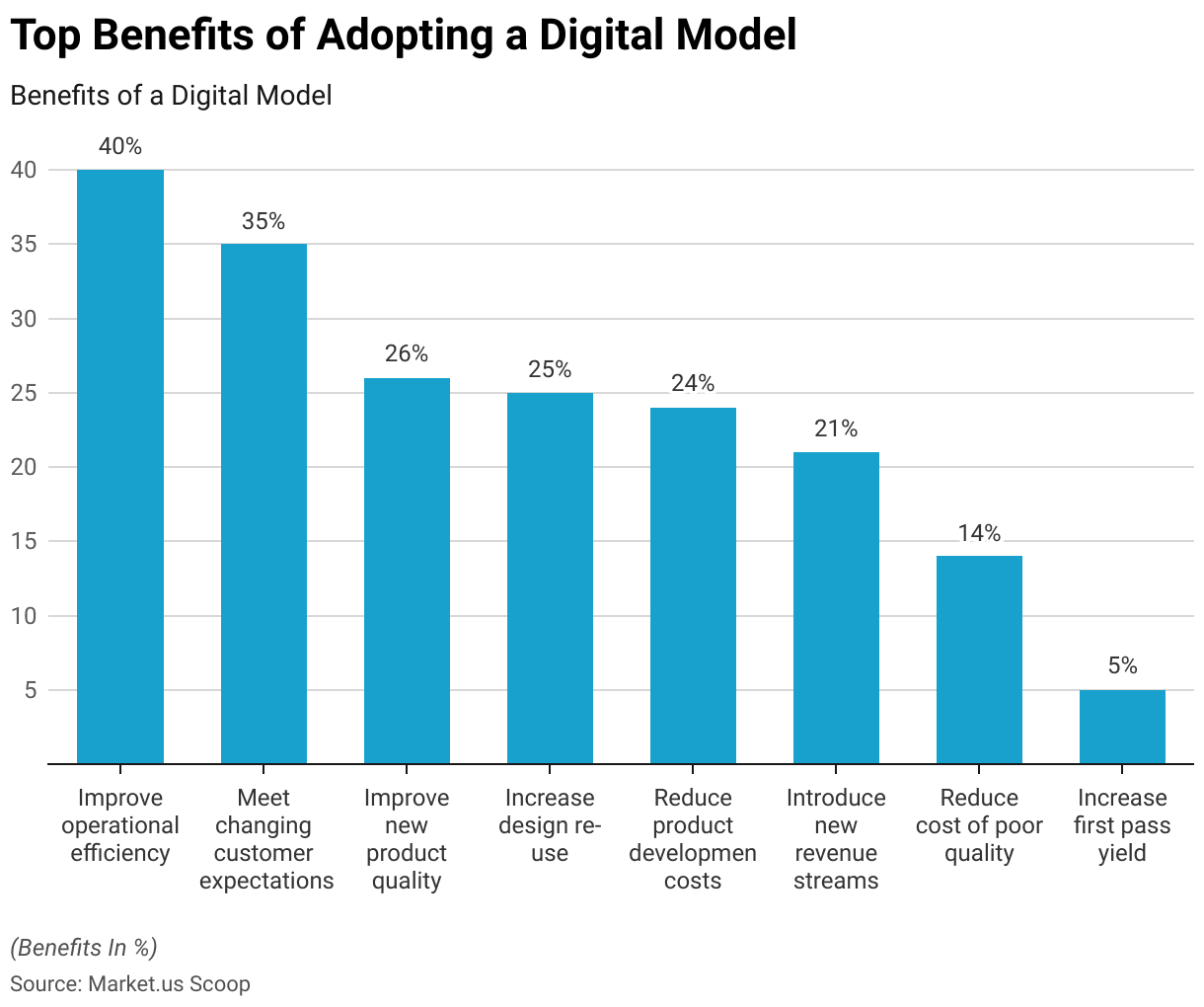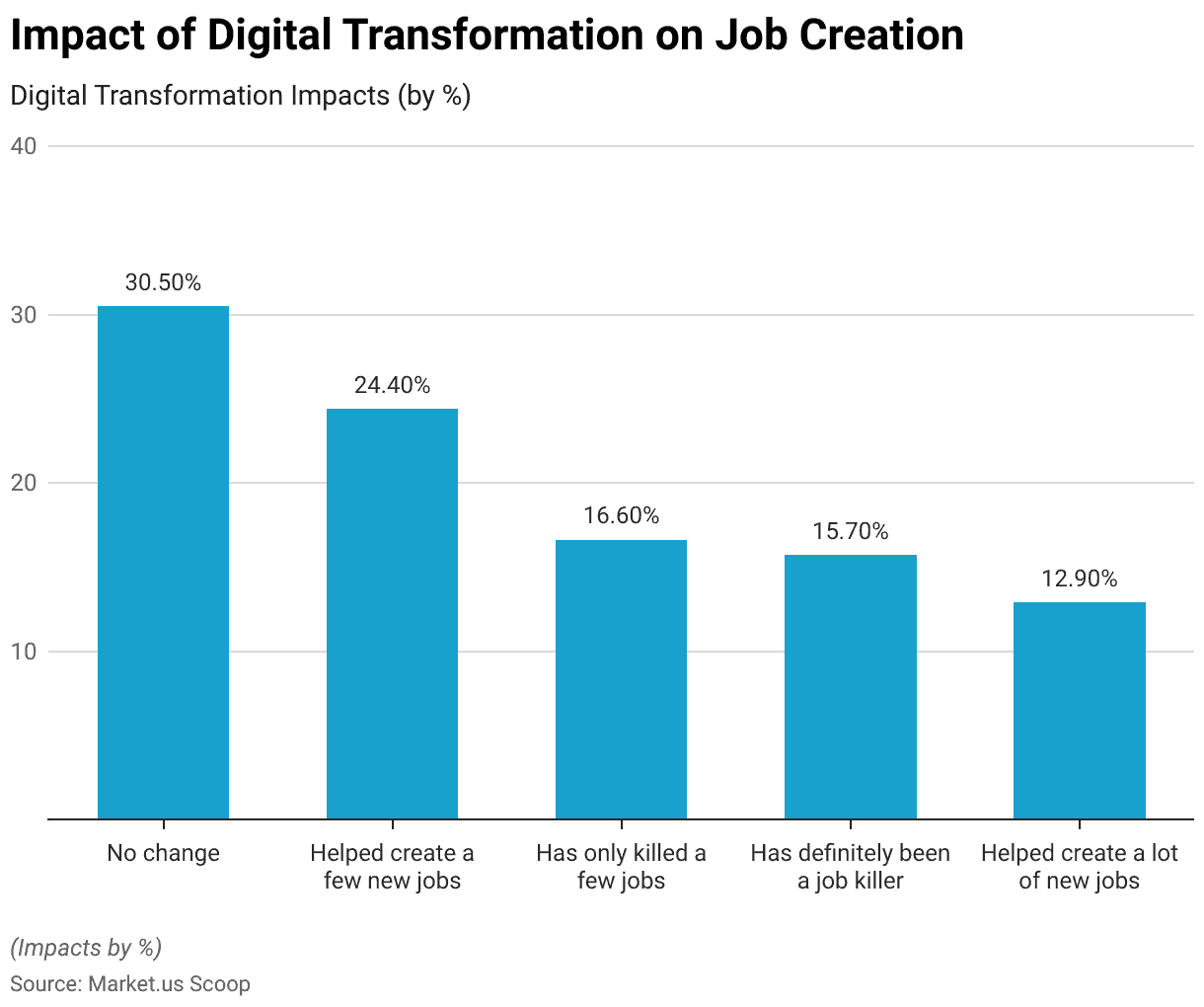Table of Contents
According to Market.us, the Global Digital Transformation Market in 2022 is estimated at 535 billion dollars and is projected to reach USD 3,375 billion in 2032. It is projected to experience a compound annual growth rate of 20.8%
Editor’s Choice
- 65% of firms currently have plans in place to strengthen collaboration among analytics teams, data science teams, and business units.
- 65% of firms currently have plans in place to strengthen collaboration among data science teams, analytics teams, and business divisions.
- Almost all firms engage in some type of digital activity.
- 87% of senior executives prioritize digitalization.
- Forty percent of businesses have advanced digital projects.
- Market pressure and growth opportunities drive 51% of digital transformation efforts.
- During the outbreak, 70% of businesses chose to boost or continue their investments in digital transformation.
- 76% of businesses expect long-term IT challenges as a result of COVID-19.
- According to COVID-19, 76% of organizations anticipate long-term IT issues.
- COVID-19 will influence more than one-third of technology budget increases in 2021.
- 97% of IT decision-makers are pursuing digital transformation projects.
- By 2024, 25% of CIOs in large corporations will be held accountable for digital business operating results, a practice known as “COO by proxy.”
- Among the top strategic technical themes that will cause disruption and growth are hyper-automation, multi-experience, democratization, and human augmentation.
Business and Digital Transformation Statistics
According to Digital Transformation Statistics, Digital transformation has quickly become ingrained in current business operations, with many firms implementing digital initiatives. Smaller businesses, as well as huge organizations, have joined in, enormously growing the market for digital transformation. Healthcare and financial services are among the industries that have taken part. Adopting such techniques does not ensure immediate success for your firm; instead, many businesses reap the benefits gradually over time.
- The Global Digital Transformation Market was valued at 535 billion dollars in 2022 and is expected to increase to 3,375 billion dollars by 2032, exhibiting a compound annual growth rate of 20.8%.
- According to IDC 2020, digitally changed firms will account for more than half of the world’s gross domestic product (GDP) by 2023, equal to $53.3 trillion; by 2022, the whole global GDP may have been digitalized.
- According to PTC 2019, 70% of firms have or are in the process of developing a digital transformation strategy.
- The industries thought to have benefited the most from digital advances are considered.
- 55% of startups have included digital strategies in their business plans.
- While the majority of traditional enterprises have likewise adopted digital-first business strategies.
- According to IDC (2018), 89% of organizations plan to or have already implemented a digital business strategy.
- Services organizations (95%), financial services (93%), and healthcare (92%) are among the industry’s most likely to implement digital strategies.
- According to Fortinet (2018) and Forrester (2018), three-quarters of CEOs expect to gain from digital transformation activities within three to five years.
- According to Forrester, 21% of North American and European businesses are undergoing this change.

Digital Transformation Technologies Statistics
Digital transformation refers to the practice of employing modern technology to transform existing business processes and existing services, using artificial intelligence (AI), cloud computing, and IoT technologies as means for digitization. Businesses use these technologies for developing digital strategies – AI statistics provide evidence for this point while digital transformation technologies data provides even more details about them.
- 58% of companies with high levels of digital maturity provide digitally connected products; 17% of lower maturity firms reported the same.
- Digital technology implementation can accelerate progress toward business goals such as financial return, workforce diversity, and environmental objectives by 22%.
- 69% of high-growth companies utilize digital technology to reduce carbon emissions; 58% of lower-maturity firms also employ this strategy.
- Successful companies coping with pandemics exhibited various technological capabilities. 75% said they were able to fill tech positions during times of crisis, 67% were more adept in using technology than their peers prior to the crisis, and 56% pioneered experimental digital technology during crises.
- 51% of digital transformation efforts stem from growth opportunities.
- 70% of executives anticipate that IoT will play an integral part in their digital marketing strategies.
- Big data and analytics technologies were the most frequently employed (58%), followed by mobile technology (59%) APIs, as well as embeddable technologies (40%).
- Top benefits for organizations include increased operational efficiency (40%), faster times-to-market (36%), and exceeding customers’ expectations (35%).
- Merely 30% of tech companies are engaged in digital transformation initiatives for organizations.
Digital Management Statistics
Many businesses have benefited from digital transformation, resulting in the widespread use of digital technologies. Unfortunately, embarking on the digital revolution does not always result in success; in fact, 70% of efforts have failed to meet their goals due to poor management strategies; tools for managing digital assets may help, but tech managers frequently overlook aspects such as business strategy, employee concerns, and customer service; all of these factors can lead to subpar results; effective management leads to positive results, as evidenced by these figures.
- According to Deloitte 2020, 29% of executives at organizations with high levels of digital maturity complemented digital transformation’s favorable impact on innovation and growth, while 41% recognized its positive impact on marketing and sales duties.
- 38% of executives aim to increase their investment in technology to achieve a competitive advantage.
- According to Futurum (2018), 70% of firms believe their CEO’s expertise in emerging technology is adequate or above average.
- According to Altimeter 2019, 28% of Chief Information Officers and 23% of CEOs are in charge of managing or supporting digital transformation projects.
- 37% of worldwide IT efforts implemented by firms aim to improve customer satisfaction. 6.39% of CEOs identify digital transformation as their top priority for CIOs.
- According to CIO 2020, 67% of CIOs see revenue-generating efforts as one of their responsibilities.
- Furthermore, 78% of IT Directors reported increased engagement with Board Directors.
- One of the major barriers to digital change is a lack of skills to lead digital projects.
Digital Spending Statistics
Companies gain significantly from transformation. Financial gains outnumber all others since this is what firms most want from digital transformation. Businesses such as Target, Best Buy, and Hasbro that took advantage of the digital revolution early on saw their profits and stock prices soar as early adopters of this transformation process reaped its benefits early on in its existence; all types of technology providers also reaped significant market share from transformation efforts; the statistics below show just how much companies have been investing in this endeavor.
- Digital transformations consume 40% of technology spending.
- The total corporate investment in digital transformations in 2019 was $2 trillion.
- It is considered expensive by 28% of businesses.
- Digital transformation is a priority for 54% of organizations globally, while cybersecurity is a priority for 49%.
- IDC 2020 estimates that global expenditures in digital transformation will total $6.8 trillion between 2020 and 2023.
- According to IDC 2020, global spending on digital transformation technologies and services will reach $2.3 trillion by 2023.
- Due to COVID-19, investment in logistics digital transformation alone might exceed $84.6 billion.
- According to KPMG 2020, IT leaders throughout the world have reported an average 5% increase in their IT budget to tackle the COVID-19 infection.
Workforce and Digital Transformation Statistics
Depending on the organization, digital transformation can have both beneficial and bad consequences for employees. Employee participation is required for digitization to occur; digitization necessitates highly sought-after digital competencies that employees must possess in order to participate. On the other hand, digitalization may have a detrimental impact on present labor markets since it creates potential for new corporate positions that require specialized sets of skills – for example, a career path toward digital project managers may diverge from traditional project management responsibilities.
- According to Industry Week (2018), 71% of CEOs consider their staff to be either extremely valuable or vital to the success of their transformation efforts.
- According to CIO 2020, 89% of IT directors perceive a rising need for consultants to help them navigate changing technologies, procedures, and methodologies.
- Furthermore, 90% of future occupations will demand digital skills.
- According to Fujitsu (2018), 68% of CEOs agree that collaboration between AI and humans is essential for business.
- Despite this, 44% of Europeans aged 16 to 74 lack basic digital literacy.
- Skills required for digital transformation, as well as technology integration and implementation, were listed at 49%.
- 15.7% of businesses indicated that technological disruption was the cause of “job death.”.

Take advantage of our unbeatable offer - buy now!

Discuss your needs with our analyst
Please share your requirements with more details so our analyst can check if they can solve your problem(s)



